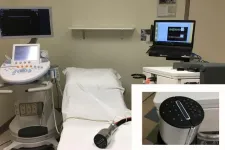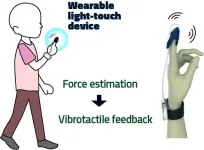New tech predicts chemotherapy effectiveness after one treatment
Early prediction of treatment efficacy may help improve quality of life for people with breast cancer
2021-06-03
(Press-News.org) While early detection of breast cancer is critical, early prediction of how well the neoadjuvant chemotherapy treatment before surgery is working also may provide a window of opportunity when treatment could be altered and have a big impact on the patient's quality of life.
An interdisciplinary team of researchers at Washington University in St. Louis has found that combining data from tumor biomarkers, ultrasound, and ultrasound-guided diffuse optical tomography (DOT) after a patient's first cycle of pre-surgical neoadjuvant chemotherapy provided a highly accurate prediction of how the tumor was responding to the treatment. The results from a clinical trial at Washington University School of Medicine and Barnes-Jewish Hospital were published online in Breast Cancer Research and Treatment May 10, 2021.
Quing Zhu, professor of biomedical engineering in the McKelvey School of Engineering and of radiology at the School of Medicine, led a team of engineers and radiologists in the three-year clinical trial involving patients with various types of breast cancer, including triple-negative breast cancer, human epidermal growth factor receptor 2 (HER2+), and estrogen receptor-positive/human epidermal growth factor 2 negative (ER+/HER2-). By conducting imaging after the first cycle of neoadjuvant chemotherapy, which ranges from two to three weeks depending on the type of treatment regimen used, Zhu said. The prediction model based on tumor biomarkers and imaging parameters can predict how well the cancer is responding.
"We found that the tumor biomarkers and near-infrared and ultrasound imaging parameters together would be the best earlier predictors to give us an area under the receiving operating curve, or AUC, of 0.94," said Zhu, a pioneer of combining ultrasound and near-infrared imaging modalities for cancer diagnosis and treatment assessment. "If we extended the imaging to the end of cycle 3 of neoadjuvant treatment, 1 1/2 to two months into the six-month treatment period, the prediction can reach AUC 0.97, the best in the literature regarding monitoring neoadjuvant chemotherapy treatment response."
In the study, 38 women patients with breast cancer underwent ultrasound and ultrasound-guided DOT prior to beginning neoadjuvant chemotherapy, at the end of each of the first three treatment cycles and prior to surgery. The DOT system consists of a 10-centimeter handheld probe and a near-infrared system developed in Zhu's lab that takes data noninvasively from the breast from nine sources and 14 detectors in less than 4 seconds.
"In this technology, the near-infrared light is delivered to the breast tissue and gets absorbed by the tumor," Zhu said. "If there is no tumor, there will be a stronger reflection of the light back to the breast tissue surface. Using a tomography image reconstruction algorithm, the tumor absorption map can be reconstructed, and the total hemoglobin concentration can be computed from absorption maps of multiple optical wavelengths. Total hemoglobin concentration is directly related to tumor vasculature. This technology is very sensitive, and light penetration depth can reach 4 centimeters to 5 centimeters, but the resolution is low, so we couple it with the ultrasound to improve the resolution."
Through this dual-modality combination, the researchers can determine if the vasculature, or blood vessel network, of the tumor is reducing and the tumor size is shrinking, which predicts a good treatment response, Zhu said. Otherwise, the tumor may not respond to treatment, and physicians may consider either early surgery or change to a different treatment regimen to improve patient treatment outcomes.
Going forward, Zhu would like to make the DOT system smaller so that it can be used at the patient's bedside in the infusion clinics. Eventually, she would like to integrate it with an existing ultrasound machine, which is compact and low-cost, to provide a dual-modality imaging assessment. She is working with the university's Office of Technology Management to commercialize the technology, which has US Patents pending.
"We could image the patient right before treatment and at early treatment cycles to help physicians decide who is responding and who is not responding," she said. "If we can decide this early on, we don't have to continue to give the patient the toxic chemotherapy drugs and find out at the end of treatment that tumors do not respond to the drugs."
INFORMATION:
[Attachments] See images for this press release:

ELSE PRESS RELEASES FROM THIS DATE:
2021-06-03
RESEARCHERS at the University of Huddersfield have warned there is an urgent need for the country's mental health interventions to create strategies optimising the use of antidepressants after conducting a study which has highlighted an alarming rise in relation to usage and costs.
The open-access study, published by the international DARU Journal of Pharmaceutical Sciences, is entitled 'Surging trends in prescriptions and costs of antidepressants in England amid COVID-19' and has investigated the trends in prescriptions and costs of various antidepressants in England during the COVID-19 pandemic.
The researchers discovered that the total number of antidepressant prescriptions drugs dispensed during ...
2021-06-03
When bringing technologies into the workplace, it pays to be realistic. Often, for instance, bringing new digital technology into an organization does not radically improve a firm's operations. Despite high-level planning, a more frequent result is the messy process of frontline employees figuring out how they can get tech tools to help them to some degree.
That task can easily fall on overburdened workers who have to grapple with getting things done, but don't always have much voice in an organization. So isn't there a way to think systematically about implementing digital technology in the workplace?
MIT Professor Kate Kellogg thinks there is, and calls it "experimentalist governance of digital technology": Let different parts of an organization experiment with the technology -- ...
2021-06-03
A new study by ecologist André de Roos* shows that differences between juveniles and adults of the same species are crucial for the stability of complex ecological communities. The research, published in Proceedings of the National Academy of Sciences, represents a major advance in ecological modeling at a time when biodiversity is declining and species around the world are rapidly going extinct.
Up to now, ecological models have focused exclusively on the interactions between species, ignoring the variations within them. The dragonflies, frogs, trout, and phytoplankton in a freshwater pond, for example, would be represented as nodes in a network, connected by edges that ...
2021-06-03
LAWRENCE -- A strange thing sometimes happens when we listen to a spoken phrase again and again: It begins to sound like a song.
This phenomenon, called the "speech-to-song illusion," can offer a window into how the mind operates and give insight into conditions that affect people's ability to communicate, like aphasia and aging people's decreased ability to recall words.
Now, researchers from the University of Kansas have published a study in PLOS ONE examining if the speech-to-song illusion happens in adults who are 55 or older as powerfully as it does with younger ...
2021-06-03
(SACRAMENTO, Calif.) - An international team of researchers, led by END ...
2021-06-03
Alexandria, Va., USA -- Dental care professionals are thought to be at enhanced risk of occupational exposure to SARS-CoV-2, but robust data to support this is lacking. The study "COVID-19: Seroprevalence and Vaccine Responses in UK Dental Care Professionals," published in the Journal of Dental Research (JDR), provides a longitudinal analysis of antibodies to SARS-CoV-2 spike glycoprotein, including early analysis of the impact of vaccination on the immune response.
In June 2020, I,507 West Midlands dental care professionals were recruited to test for baseline seroprevalence, or the proportion of the population that have circulating antibodies to SARS-CoV-2, indicating prior ...
2021-06-03
Viruses can spread not only via droplets or aerosols like the new coronavirus, but in water, too. In fact, some potentially dangerous pathogens of gastrointestinal diseases are water-borne viruses.
To date, such viruses have been removed from water using nanofiltration or reverse osmosis, but at high cost and severe impact on the environment. For example, nanofilters for viruses are made of petroleum-based raw materials, while reverse osmosis requires a relatively large amount of energy.
Environmentally friendly membrane developed
Now an international team of researchers led by Raffaele ...
2021-06-03
People in both the United States and China who think others are being duped by online misinformation about COVID-19 are also more likely to support corporate and political efforts to address that misinformation, according to a new study. The study suggests negative emotions may also play a role in the U.S. - but not in China.
"A lot of misinformation has been shared online over the course of the COVID-19 pandemic, and we had a range of questions about how people are responding to this misinformation," says Yang Cheng, co-lead author of the study and an assistant professor of communication at North Carolina State University.
"How do different emotions influence ...
2021-06-03
Japanese researchers have developed and tested a prototype device -- wearable on the fingertips -- that incorporates the concept of 'light touch' to enhance the sense of balance. If widely implemented, the device should significantly reduce incidence of falls amongst seniors.
The findings are published in the journal Scientific Reports on April 1.
As we age, our sense of balance can become impaired. The resulting increase in postural sway in turn increases the risk of falls and consequent injuries. Meanwhile, older people make up a large and increasing proportion of the population in highly developed countries. ...
2021-06-03
Research involving scientists from the University of A Coruña has succeeded in sequencing the oldest mitochondrial genome of the immediate ancestor of modern cows that has been analysed to date. The remains, some 9,000 years old, were found next to a woman. Why were they with her if cattle had not yet been domesticated? Do they belong to ancestors of today's Iberian cows?
Humans have maintained a very close relationship with aurochs (Bos primigenius) since their beginnings, first by hunting them and then by breeding and selecting them.
This extinct species of mammal is little known in the Peninsula because its skeletal remains are difficult to distinguish from bison. In fact, there have been references to the presence of "large bovids" in many sites because ...
LAST 30 PRESS RELEASES:
[Press-News.org] New tech predicts chemotherapy effectiveness after one treatment
Early prediction of treatment efficacy may help improve quality of life for people with breast cancer



